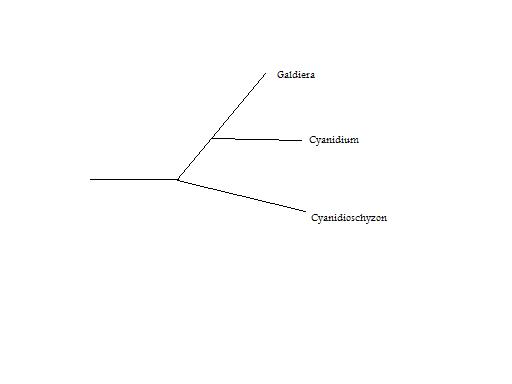
Cyanidium's place in the tree of life
Domain-->Eukaryota
Kingdom--> ProtistaPhylum--> Rhodophyta
Class --> RhodophyceaeOrder--> Cyanidiales
Family--> Cyanidiaceae
Genus-->Cyanidium
Species--> caldarium
Cyanidium caldarium is classified as a Eukaryote because it contains a true nucleus and membrane bound organelles.
The kingdom Protista is essentially a dumping ground for organisms that do not fit into any of the other kingdoms
.Cyanidium caldarium is classified as a member of the Rhodophyta because it contains the photosynthetic pigment, phycoerythrin
, and because it lacks flagella.Rhodophyceae is the sole class of the phylum Rhodophyta
.Cyanidium caldarium is classified as a member of the Cyanidiales because it is asexual, unicellular and has the ability to grow in hot and acidic environments. This order contains three genera. These genera are Cyanidium, Galdieria, and Cyanidioschyzon.
The cyanidiales are believed to have seperated from the rest of the rhodophyta over 1.3 billion years ago. Galdiera sulphuraria will soon be the first Cyanidiale to have its genome sequenced.Cyanidiaceae is the sole family of the order Cyanidiales.
Cyanidium is separated from the other Cyanidiales based on genetic data.
Cyanidium caldarium is the sole species of the genus Cyanidium.
Its name refers to its blue-green color and to its preference for hot environments.

The Cyanidiales have been grouped into three genera based on genetic evidence. The genes used to differentiate them were psaA, psaB, and rbcL.

According to the supergroup method of classification, Cyanidium and other red algae are part of the supergroup Archaeplastida. Other members of this group include green algae and members of the kingdom Plantae.